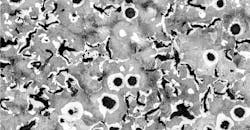SinterCast CGI Series Output Still Rising
Foundries that melt compacted graphite iron using SinterCast AB control technology shipped roughly 17,916 metric tons of castings during August, or 215,000 metric tons/year at an annualized rate. That set a new monthly record for shipments of SinterCast CGI castings, topping the previous record set in June, 205,000 annualized metric tons/year.
CGI is a lightweight cast iron that offers greater tensile strength, stiffness, and fatigue strength than gray iron or aluminum. Stockholm-based SinterCast – which developed and licenses the most widely adopted process technology for melting CGI – records its licensees’ shipments as “engine equivalents” (50 kg), indicative of the material’s most common application in series production, casting gas and diesel engines blocks and cylinder heads. On that basis, the August shipment total is annualized as 4.3 million “engine equivalents.”
Despite slower summer production schedules for some important SinterCast customers, the July-August period resulted in an 11% year/year increase in production volume, it detailed.
“With average production of 4.0 million engine equivalents over the last four months – including the summer shutdown season – we have clearly established four million as the new normal,” stated SinterCast president and CEO Dr Steve Dawson.
More practically, SinterCast noted that the August volume would correspond to production of approximately 100,000 vehicle engines, almost all of which would be commercial vehicles, pick-up trucks, and off-road equipment. In those vehicle market segments, CGI engines contribute fuel efficiency and CO2 emissions reductions.
“Ultimately, the August production will contribute to the saving of more than one million metric tons of CO2 over the life of the vehicles,” SinterCast projected.
